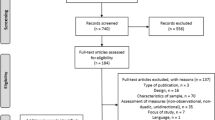Abstract
The interactions of working-class mothers and their firstborn children were studied in a playroom situation shortly before, as well as shortly after, the mother delivered a new baby. Both mothers and children exhibited less warmth and increased neutral affect subsequent to the birth of the new baby. Thus, in the sample, the analytic view that birth of a sibling has a major effect on the mother-child relationship was confirmed.
Similar content being viewed by others
References
Freud S:A General Introduction to Psychoanalysis. London, Bone & Liveright, 1924.
Wimberger HC, Kogan KL: Interpersonal behavior ratings.J Nerv Ment Dis 147:260–71, 1968.
Siegel S:Nonparametric Statistics for the Behavioral Sciences. New York, McGraw-Hill, 1956.
Hilton I: Differences in the behavior of mothers toward first- and later-born children.J Pers Soc Psychol 7:282–90, 1967.
Kilbride H, Johnson D, Streissguth AP: Early home experiences of newborns as a function of social class, infant sex, and birth order. Unpublished paper, University of Washington, 1971.
Schachter S:The Psychology of Affiliation. Stanford, Stanford University Press, 1959.
McGurk H, Lewis M: Birth order: A phenomenon in search of an explanation.Dev Psychol 7:366, 1972.
Kogan KL, Wimberger HC: Behavior transactions between disturbed children and their mothers.Psychol Rept 28:395–404, 1971.
Schooler C: Birth order effects: Not here, not now!Psychol Bull 78:161–75, 1972.
Kohn ML: Social class and parent-child relationships: An interpretation. In F Reissman, J Cohen, and A Pearl (Eds),Mental Health of the Poor. New York, Free Press of Glencoe, 1964.
Kogan KL, Wimberger HC: Interaction patterns in disadvantaged families.J Clin Psychol 25:347–52, 1969.
Bernstein B: Social class, speech systems, and psychotherapy. In F Reissman, J Cohen, and A Pearl (Eds),Mental Health of the Poor. New York, Free Press of Glencoe, 1964.
Bee HL, Van Egeren LF, Streissguth AP, et al: Social class differences in maternal teaching strategies and speech patterns.Dev Psychol 1:726–34, 1969.
Holmes TH, Rahe RH: The social readjustment rating scale.J Psychosom Res 11:213–18, 1967.
Author information
Authors and Affiliations
Additional information
This research was sponsored by a grant from the University of Washington Graduate School Research Fund.
Rights and permissions
About this article
Cite this article
Taylor, M.K., Kogan, K.L. Effects of birth of a sibling on mother-child interactions. Child Psych Hum Dev 4, 53–58 (1973). https://doi.org/10.1007/BF01434184
Issue Date:
DOI: https://doi.org/10.1007/BF01434184




